Colchester City Centre Masterplan SPD
(45) 02 Vision and Masterplan
Vision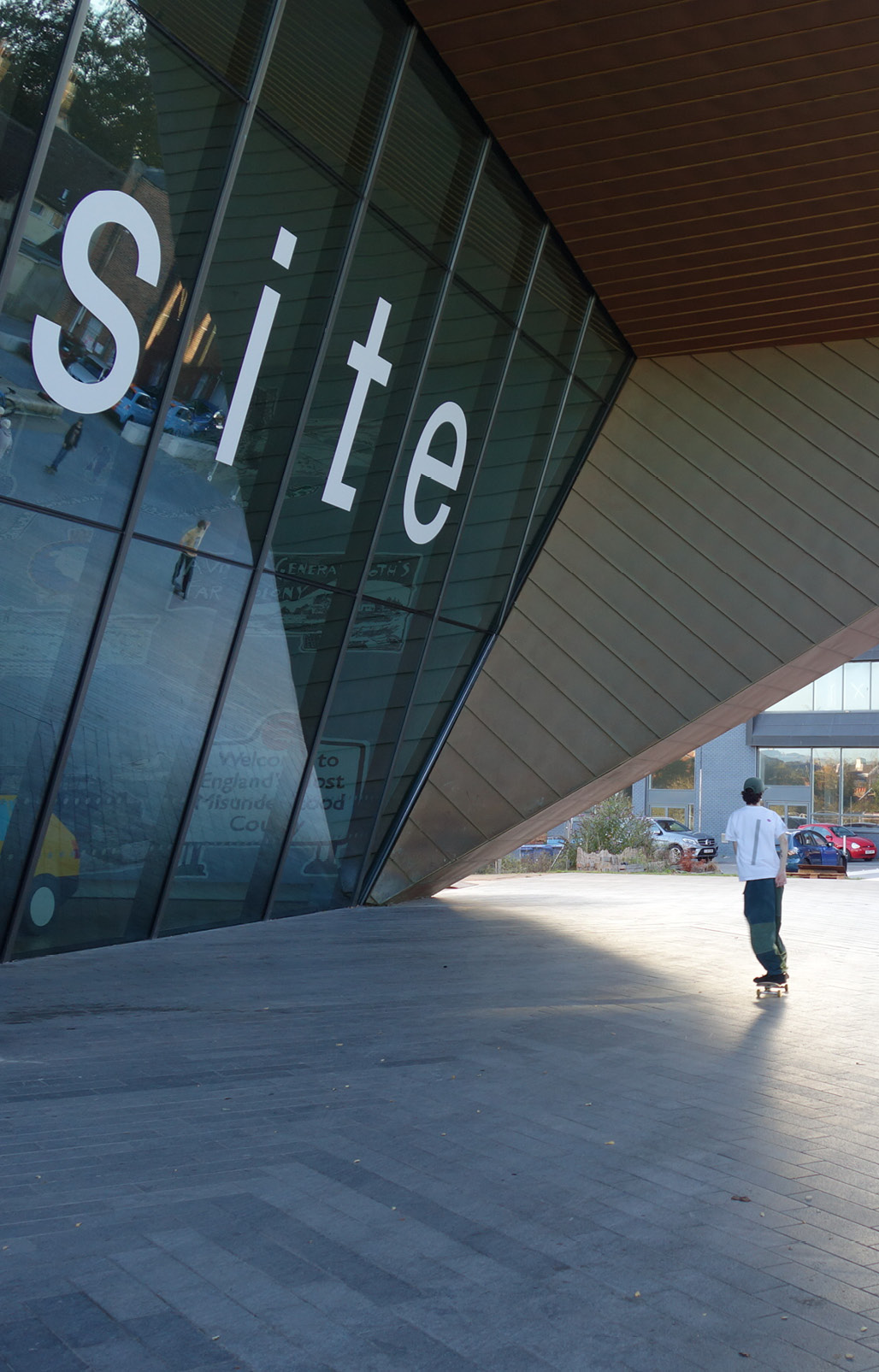
Colchester was the UK’s first city, and regained its status in 2022 to become one of its newest, too. It has all the potential to meet the twin challenges of the climate emergency and wider economic trends with bold, yet pragmatic, approaches.
Together, the proposals in this plan will support Colchester’s development over the coming decades, with a respect for its past and ambition for its future.
Colchester’s heritage should be source of pride for residents, and attract visitors from across the region and the country. Development of the city centre must create quality streets and spaces that provide the perfect setting for historic buildings, and make a walkable, enjoyable environment for everyone.
The city centre economy should be amplified with more diverse activities, including markets, community uses, independent retail and food and drink, and workspace for the creative and digital sector. This will create more high quality jobs in the city centre and sustain other businesses in turn.
People living in the city centre also sustain local businesses and make it a lively and vibrant place. Good quality and affordable homes, tapping into the appeal of city centre living, will support local shops and services, and the transition to low-carbon lifestyles.
As many people as possible should walk, cycle or use public transport to travel into the city centre. This is critical for reducing carbon emissions, improving air quality, and making the city a more pleasant place to spend time. This means re- connecting neighbourhoods to the city centre with attractive and easy walking and cycling routes; and improving public transport, particularly bus provision and including the new Rapid Transit System.
Reducing unnecessary traffic will mean that people who still need to travel into the city centre by car, will be able to do so more reliably. They should be able to park in safe and accessible locations, or be dropped off and picked up easily. Deliveries to and from businesses, by day and night, must be fully considered, along with improving the interchanges between different modes of transport.

Developing the Masterplan
The diagram overleaf outlines the structure of the Masterplan. The column to the left lists the five layers of the City Centre Masterplan, each corresponding to a theme from the Better Colchester Strategic Plan 2020-2023. The column to the right lists the ten urban design strategies that support the masterplan; each masterplan layer aligns with two corresponding urban design strategies.
In this document, the five Masterplan layers are separated onto their own pages: taken all together they form the City Centre Masterplan.
The masterplan layers take a wider view on the city centre, considering the connections between the city centre and its immediate wider surroundings.
The urban design strategies take a more detailed view, and focus on interventions within the retail heart of the city centre. The interventions shown in the urban design strategies also work towards achieving the objectives set out in their corresponding thematic masterplan layer.
Suggested interventions include both measures and changes that can be linked to a specific city centre geographical location, as well as those that cannot, but are equally as important for implementation to achieve the Masterplan objectives.





Actively Respond to the Climate Emergency
Masterplan Layer
This masterplan layer aims to reduce pollution and carbon emissions by providing ways for nearby communities to travel to the city centre by walking, cycling and public transportation. This includes providing spaces for residents to park their cars on the periphery of the city centre and switch to more sustainable travel options while moving around the city centre.
In the context of a heavily built up and historic city centre, the measures that can have the greatest positive impact on the environment while being least disruptive to the historic fabric are related to transportation and reducing emissions from motor vehicles.
Therefore, the first set of strategic moves relate to linking wider communities, providing sustainable modes of travel into the city centre. This includes defining city gateways, which serve as entry points into the city centre and allow for travellers coming by car, bus or rail to switch to more sustainable modes of travel.
The second set of strategic moves relate to environment and sustainability within the city centre. They aim to reduce congestion and emissions in the city centre, and provide modes of sustainable travel to get around the city centre.
 Linking to communities in the wider area
Linking to communities in the wider area
- Encouraging active travel with high quality strategic walking and cycling routes
- Improving public transport and ensuring integration of the future Rapid Transit System (RTS)
- Defining key city gateways as arrival points
- Improvements to existing car parks
 Environment and sustainability
Environment and sustainability
- Implementing a car-lite city centre and a zero-emissions zone in the city centre
- Ensuring key north-south and east-west city centre corridors provide clear, legible routes for active travel.
What We Learned
- Road traffic growth and significant congestion can occur during peak times on the limited number of routes in and out of the city centre
- A large part of the city centre is covered by an Air Quality Management Area due to emissions from road traffic
- A dispersed bus facility model in the city centre due to the its existing ring road configuration
- The Colchester Rapid Transit System proposals aiming for a ‘trackless tram’ connecting east to University of Essex Colchester Campus and Tendring/Colchester Borders Garden Community
- Pre-pandemic car parking data indicates up to 800 public car parking spaces available across the city centre during peak periods
- Extensive network of walking and cycling routes in and around Colchester.
What You Said
- Poor public transport options for accessing the city when travelling from outside of the city centre; the park and ride would be an alternative, but it is just as quick, easy and cheaper to drive and park in the city centre
- Traffic is a big problem at most times of the day
- There is an appetite for using car modes less and using alternative modes more.

Linking to Communities in the Wider Area
Urban Design Strategy
Interventions include:
- Active travel
- Ensure safe routes into the centre and key activity destinations by walking and cycling
- Improve cycling and walking routes from mainline station to the city centre, and from city centre to University campus and Tendring/Colchester Borders Garden Community
- Wider cycling route connections (beyond those in LCWIP) - including those in Colchester Cycling Campaign’s analysis shallow gradient alternative to North Hill (route through Dutch Quarter) and the shallow gradient alternative to East Hill (Rosebery Avenue through to Britannia Yard).
- Segregated cycle lanes along East Hill, North Station Road/ North Hill (narrow carriageway to 6m), and Lexden Road (upgrade from advisory to full segregation)
- Rapid Transit System (RTS) - Ensure effective integration in order to deliver accessibility, speed and reliability
- Buses
- Enhancement of the quality of all bus infrastructure
- Investigate opportunities to enhance night transport to support evening/night workers, as well as visitors
- Improved passenger waiting facilities and provision of additional Real Time Passenger Information (RTPI) screens to support increased bus use
- Use of technology and traditional information wayfinding to encourage use of public transport
- Investigate the potential to extend bus service timetables further into the evening and on Sundays to/from park and ride locations
- Working with bus operators to identify opportunities for rationalising services to reduce bus congestion, whilst protecting levels of service
- Potential use of land at or close to Stanwell House site as a means of expanding existing facility at Osborne Street, for bus stands to free up congestion within the city centre core
- Investigate the potential to run a frequent shuttle service from Colchester rail station through the city centre.
- City gateways
- Areas at major road junctions that serve as regional arrival and departure points that allow for interchanges between medium or long- distance travel modes (car, RTS, buses, Demand Responsive Transport (DRT), and/or rail) with last-mile modes
- Priority city gateway: St Botolph’s roundabout
- Improvements to existing car parks
- Implement flexible parking charges (pay on exit
or a linear tariff) - Enhance car parking with attractive access forecourts and internal pedestrian routes
- Integrate electric vehicle charging infrastructure
- Expand the car club offer with additional allocated space at car parking and promotion
- Index-link parking fees with public transport, park and ride and shared transport options
- Support the use of park and ride through a reduction of long-stay parking options
- Create satellite urban logistics hub at car parks with spare capacity
- Ensure parking provision continues to meet demand when carparks earmarked for redevelopment are redeveloped
- Implement flexible parking charges (pay on exit
- Accessibility and inclusivity
- Implement inclusive and accessible wayfinding focussed on movement between arrival points and places of interest
- Ensure well-designed, accessible car parking at key locations.
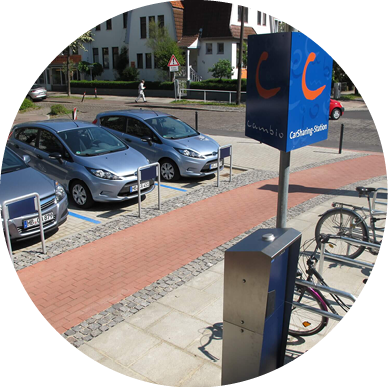

Environment and Sustainability
Urban Design Strategy
Interventions include:
- Car-lite access restrictions
- Allows buses, taxis, goods vehicles and cycles only within the city centre central core (including High Street and St John’s Street), with access-only streets for private motor traffic
- Can help connect green spaces, leisure, sport and community hubs through active travel, and would drastically improve the pedestrian and cyclist environment
- Reducing motor traffic levels to volumes (500 vehicles per hour or lower) would meet LTN 1/20 standards for mixing cycling with motor traffic
- Long-term goal: implement a Zonal Traffic Circulation plan to the wider-area to significantly reduce through-traffic in the city centre
- City centre Zero Emission Zone (ZEZ)
- Reduce motor traffic volumes in the urban core to create a more pleasant environment for walking and cycling, and improve localised air quality
- Can support modal shift towards zero/low carbon modes and sustainable travel and further provide interventions that will help to mitigate the negative impacts from private car use.
- City centre corridors
- Key east-west and north-south corridors that aim to consolidate and extend pedestrian-friendly streets, create coherent active travel experiences between key sites and rationalise vehicular movement. Highest priority corridors are:
- Balkerne Gate - Culver Street West - priority east-west corridor between St Mary’s Car Park to the west, the Mercury Theatre, through to Firstsite to the east
- Red Lion Yard - Stanwell Street - priority north-south corridor from the Dutch Quarter through the core city centre, Vineyard Gate, the improved bus interchange at Osborne Street, down to the Roman Circus to the south
- Sustainable travel modes within the city centre
- Implement a Digital Demand Responsive Transport (DDRT) service along city centre corridors - a flexible shuttle-bus that creates routes based on demand and data from users
- Expand and enhance the existing shared micro-mobility offer (cycles for hire, e-scooters) within and around the city centre, including: integrating micromobility services / mobility hubs at car parks
- Delivery consolidation
- Integrate parcel lockers on streets with high footfall, transport interchanges and car parks
- Create a last-mile delivery hub near Colchester Town rail station
- Additional built fabric interventions
- Retrofit at scale - seek adaptive reuse of existing structures where possible, to reduce embodied carbon impacts
- New buildings to be built and older buildings to be refurbished with net zero in mind
- Review opportunities for roofspace solar panels or green roofs
- Long-term goal: zero waste zones within the city centre.
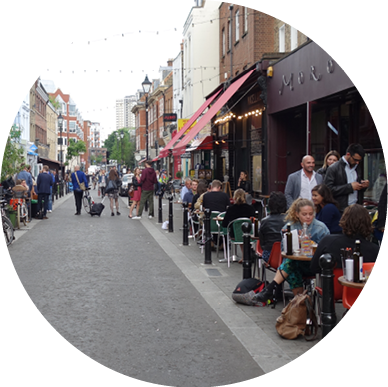
Restricted vehicular access allowing for on street spill out, Exmouth Market, London
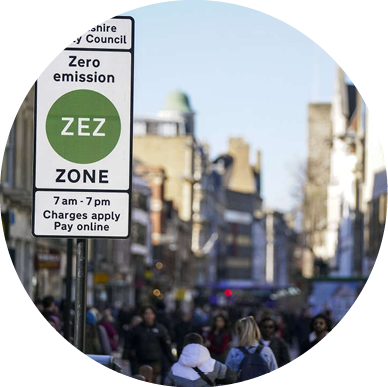
Zero Emission Zone in Oxford

Provide a Safe, Healthy, Active and Accessible City Centre
Masterplan Layer
This masterplan layer is primarily focused on integrating improvements to the public realm with increased cycle access and enhanced pedestrian experience of the city centre.
The first set of strategic moves relate to improved pedestrian and cycle permeability into and within the city centre. This is supported by providing new and improved pedestrian crossings across large vehicular routes and ensuring new pedestrian routes as part of new developments.
The second set of strategic moves, which are related to public realm, involve creating a Roman Wall Park, animating the river Colne and improving the public realm around Southway in conjunction with the proposed improved crossing points.
 Public realm, open space and landscape
Public realm, open space and landscape
- Roman Wall Park - new city park that considers the Roman Wall and its setting in its entirety
- Animating the river and using it to its full potential as a social and economic driver
- Public realm improvements along Southway
- Design vision for High Street and Head Street
- Design vision for St Bolotph’s Street, St John’s Street and Osborne Street
 Permeability and connectivity
Permeability and connectivity
- Improved connection to Colchester mainline station
- Improved key junctions and introducing new pedestrian crossings
- Improved pedestrian connectivity with the Roman Circus
- Long-term aspiration of reinstating the Culver Street East and West connection
What We Learned
- Stark pedestrian severance across Southway
- Topography creates challenges for active travel
- Disconnected and disjointed cycling routes
- Health and disability deprivation primarily affecting residents within the city centre and areas to the east/southeast - opportunity to improve access to greenspaces.
What You Said
- Conflict between pedestrians and cyclists/e- scooter users travelling on pavements
- Public gathering spaces are important as they offer informal, low pressure environment for interaction
- Concerns around safety in Crouch Street underpass
- Wish for segregated, continuous and direct cycle lanes and safe cycle cycle parking distributed throughout the city centre.
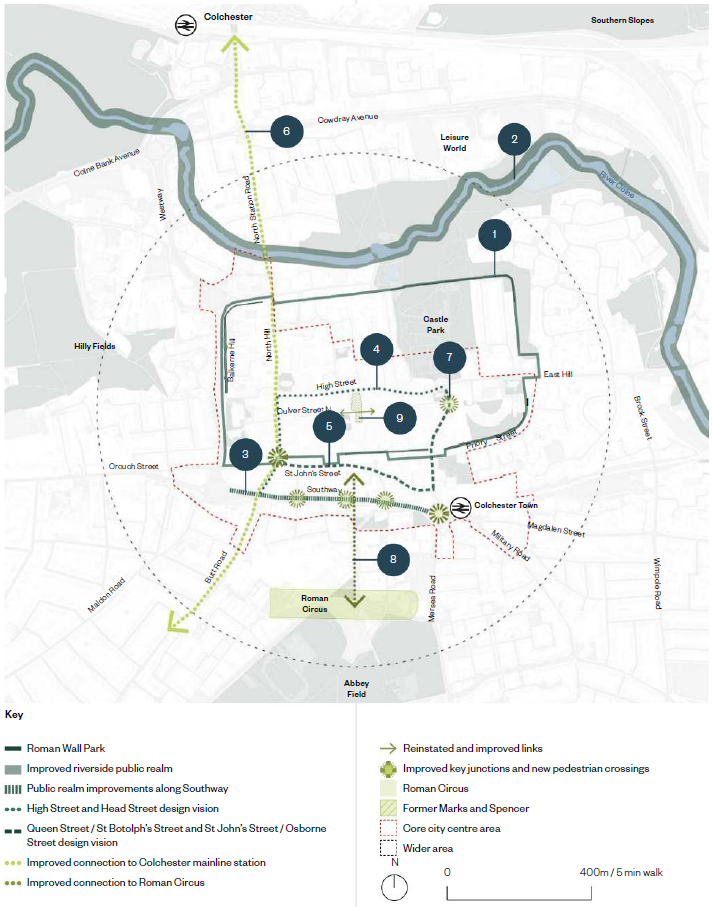
Permeability and connectivity
Urban Design Strategy
Interventions include:
- Accessible and inclusive city centre
- Any new intervention should comply to the highest standard of accessibility and inclusion requirements
- Implement inclusive and accessible wayfinding focussed on movement between arrival points and places of interest, including from Colchester and Colchester Town rail station to major city centre destinations
- High Street - Improved as a multi-functional, low-traffic public space which balances the needs of all users, rather than prohibiting vehicular traffic entirely - for more detail refer to Design Frameworks in section 3
- Improved connection to Colchester mainline station along North Station Road - Improved pedestrian environment including wider footpaths, cycling infrastructure, signage, etc.
- Connectivity, active travel improvements and public realm upgrade of the three city gateways in order to mark arrival and orient visitors towards the shopping core and key attractions
- New pedestrian crossings at Southway to improve connectivity with surrounding neighbourhoods
- Improved public realm and pedestrian crossing at Queen Street junction with Culver Street East
- Improve Head Street / St John’s Street / Crouch Street junction
- Improved pedestrian links
- From Vineyard Gate to Eld Lane (including lift/accessible route)
- Explore long-term feasibility of reconnecting Culver Street East and West with landowners
- Improved pedestrian connectivity with the Roman Circus
- Ensure new developments make provisions for new routes that enable sites to connect well to their surroundings
- Ensure new developments include infrastructure that enables and encourages active travel.

Improved junction and pedestrian realm
South End, Croydon, London
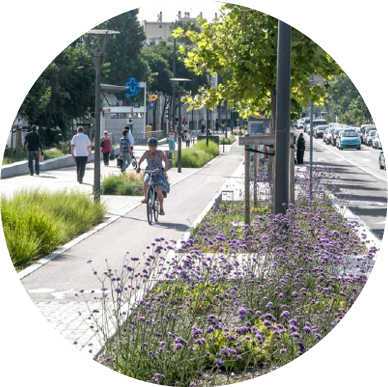
Segregated cycle path
Lyon, France

Narrowed carriageways and improved pedestrian environment on high street - Fishergate, Preston

Public Realm, Open Space and Landscape
Urban Design Strategy
Interventions include:
- Roman Wall Park - new city park that considers the Roman Wall and its setting in its entirety with joined up existing open spaces along the walls and walking routes as close to Wall as possible
- Ensure new developments create public access to the Wall, work with landowners to link currently disconnected areas and increase public access to both sides of the Wall, improve public realm around the Wall to enhance its setting
- Develop integrated design for High Street and Head Street as a multi-functional public space which meets the needs of priority users and businesses
- Develop design vision for Queen Street / St Botolph’s Street and St John’s Street / Osborne Street that integrates public transport, cycling and walking and create attractive and safe streets at all times of day and night
- Develop design vision for Southway, integrating at-grade crossings, tree planting and pavements (also unlocks potential development sites adjacent)
- Continue to improve city squares and churchyards
- Continue to improve lanes within core city centre area as level surface streets to improve accessibility for pedestrian users, in particular people with mobility and visual impairments
- Develop riverside access and amenities - e.g. paddleboarding, swimming, canoeing
- Introduce public realm design code covering surfacing, lighting, street furniture and planting to ensure consistency and legibility - further explained in relation to city centre character areas in Placemaking Within the City Centre
urban design strategy.

Tower of London Superbloom, London
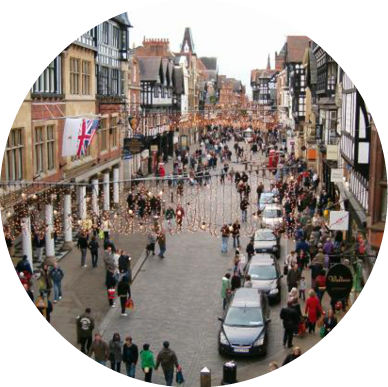
High quality high street public realm - Eastgate Street, Chester
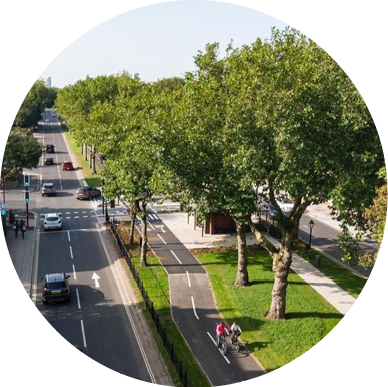
Transformation of a historic boulevard with a series of heritage installations along it - Princes Avenue, Liverpool

Diversify City Centre Uses to Encourage Footfall
Masterplan Layer
This masterplan layer and accompanying urban design strategies provide frameworks for future development in the city centre. With the appropriate land use and built form parameters, new uses such as housing can be introduced into the city centre in a contextually-sensitive and economically beneficial way.
In order to to establish a vibrant mix of uses that result in an active, sustainable city centre and support both an active daytime and nightime economy, the first urban design strategy relates to appropriate land uses of both ground and upper floors.
The accompanying urban design strategy relates to appropriate building heights, with a particular aim at informing the height and massing of any new city centre development, including new residential allocations as defined in the Local Plan.
Both urban design strategies use character areas to define appropriate uses and built form for each individual area.
 Land use strategy
Land use strategy
- Achieving an appropriate and sustainable mix of uses that activates the city centre
- Ensuring an appropriate balance of uses within the Primary Shopping Area.
More detailed development frameworks have been prepared for the following key sites:
- Former bus station site
- Britannia Yard
- Vineyard Gate
 Building heights, density and built form
Building heights, density and built form
- Ensure new developments are of appropriate city centre height and density.
What We Learned
- Areas in and near the city centre have seen population growth in families with school-age children and older people
- 55+ population will grow at faster rate than overall population during next decade
- A challenge for Colchester is to encourage residents to visit the city centre throughout the week
- Academic research on the estimated impact of working from home at the MSOA (neighbourhood) level indicates that Colchester city centre could be negatively affected by home working.
What You Said
- There was concern from some respondents related to building additional housing in the city centre; this was mostly related to impacts on traffic and the historic environment, both of which need careful consideration.

Land Use Strategy
Urban Design Strategy
The aim is to establish a vibrant mix of uses in order to ensure an active, sustainable city centre, creating both active day time and nightime economies.
Prioritising identity areas around different uses within existing character areas to ensure a cohesive series of distinct areas are defined. The following uses within existing character areas are encouraged:
 Retail and city centre uses, including restaurant, bar and cafe uses, cultural and community facilities, and other entertainment and leisure uses. Commercial or residential upper floor uses to be permitted, with residential use mix to be compatible with a city centre location.
Retail and city centre uses, including restaurant, bar and cafe uses, cultural and community facilities, and other entertainment and leisure uses. Commercial or residential upper floor uses to be permitted, with residential use mix to be compatible with a city centre location.
Ground flood use class: E and sui generis
Potential for upper floor residential, use class: C
 Retail centre uses should meet the requirements set out in the Local Plan:
Retail centre uses should meet the requirements set out in the Local Plan:
- Maintain a high proportion of retail uses on each Primary Street Frontage within the Primary Shopping Area (70%)
- Within the Secondary Street Frontages support will be given for the continuing role of retail uses supported by other activity-generating city centre uses which enhance the vitality and activity of the area, including food and drink premises, non- residential institutions and leisure uses, at ground floor level (50%).
Potential for upper floor residential, use class: C
 Predominantly residential with some active ground floor uses compatible with residential uses.
Predominantly residential with some active ground floor uses compatible with residential uses.
Use class: C3
 New residential-led development with some active ground floor uses. Refer to site-specific strategies for recommended use mix
New residential-led development with some active ground floor uses. Refer to site-specific strategies for recommended use mix
 Predominantly cultural institutions with associated open space. Use class: F1 and sui generis
Predominantly cultural institutions with associated open space. Use class: F1 and sui generis
 Predominantly commercial, business, service or community uses, with potential for commercial or residential at upper floors
Predominantly commercial, business, service or community uses, with potential for commercial or residential at upper floors
 Educational uses
Educational uses
 Transport and car parking.
Transport and car parking.
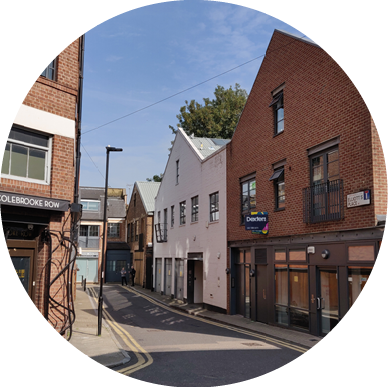
Integration of new with old, active ground floors with residential upper floors - Angel, London
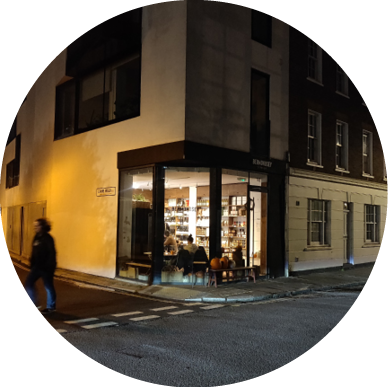
Active corner in a new build within a historic urban fabric adding life to an evening on the street - Bermondsey, London
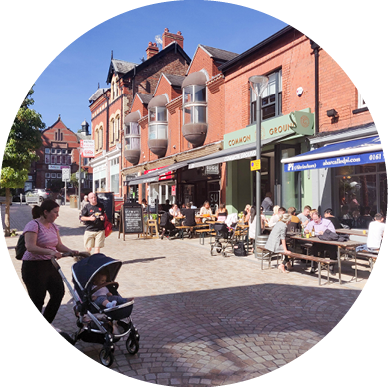
Active ground floors and outdoor seating supported by a high quality public realm - Shaw’s Road, Altrincham, Greater Manchester

Building Heights, Density and Built Form
Urban Design Strategy
The building heights framework uses character areas to determine zones of appropriate building heights. Maximum heights are determined by the prevalent building form within each character areas, the city centre’s topography and opportunities for potential new views and landmarks. Key views to existing landmark should be preserved and protected.
The heights strategy follows the following principles:
- Consolidate taller scale around High Street / Head Street and within lower topographical areas which allow for screening.
- Sensitive scale required within the Dutch Quarter and other low-scale residential neighbourhoods
- Ensuring appropriate heights and built form that enhance the setting of heritage assets.
For height, density and built form with development sites, refer to Design Frameworks in section 3.
Key
 1 storey
1 storey
 2 storeys
2 storeys
 3 storeys
3 storeys
 4 storeys
4 storeys
 5 storeys
5 storeys
 6 storeys
6 storeys
 7+ storeys
7+ storeys
 Core city centre area
Core city centre area

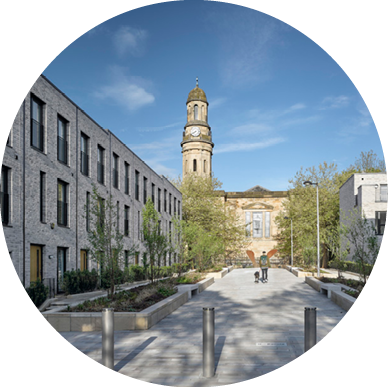
City centre residential housing with public realm and neighbouring listed church - Timekeepers Square, Salford
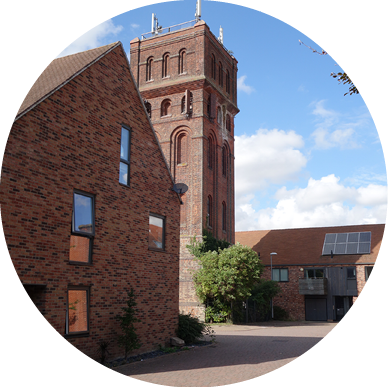
Award-winning residential development next to a historic water tower The Avenue, Saffron Walden

Mix of old and new with a range of heights respectful of existing character - Curtain Road, Shoreditch, London

Support the City Centre Economy to Everyone’s Benefit
Masterplan Layer
This masterplan layer aims to guide the future economy of the city centre, creating a framework for diversifying uses away from a reliance on retail by strengthening the existing cultural, workspace and evening offer to re-energise the city centre’s economy.
This means ensuring that there are options in the city centre that aren’t only about shopping. These can include eating out, experiences, leisure, meeting friends, events, festivals, heritage tours etc. The strategic moves include strengthening the two clusters of cultural spaces at either end of High Street and ensuring strong links between them. Expanding the offer of cultural events, supporting the evening economy and establishing links with the University will aid in attracting and retaining a younger workforce. The local economy can also be supported through updates to the current outdoor market. Finally, opportunities for circular re-use should form part of the city centre’s future economy.
 Diverse economy
Diverse economy
- Uses and mix of uses along within the Primary Shopping Area to support the city centre’s role at the top of the centre hierarchy
- Support and strengthen the creative and digital clusters at either end of High Street and links between them
- Incorporate workspaces as part of new developments
- New uses for empty department stores
- Support links with the University of Essex Colchester Campus
- Support the evening and nightime economy.
What We Learned
- Against comparators, Colchester appears to have more nightime, retail and hospitality businesses and jobs; 30% of the city centre’s jobs are in retail, hospitality, leisure and recreation - these are important for vitality but often experience low pay and poor job security
- Strong and diverse arts, cultural, digital and creative sector
- Despite a regular influx of students coming to the University or Essex, retention of young working professionals is low
- A variety of new sectors such as ICT, media, creative services and engineering have appeared in the city centre in the last five years.
What You Said
- Digital and creative sector struggling to attract high quality staff, despite availability of jobs
- Wish for a larger variety of the city centre offer
- Businesses would like to see increased spend as pat of post-Covid recovery
- Closure of M&S and Debenhams are opportunities to introduce more local, independent businesses and community facilities
- Independent shops are an asset to the city and should be supported and protected
- Improved evening offer and concerns about the city centre atmosphere and safety at night
- Young adults not feeling like there is an offer suited for them in the city centre
- More activities for kids and teenagers in the city centre e.g. trampolining, festivals, concerts, sports facilities
- Dispersed offer of weekly market, positive views on monthly farmers market.

Diverse Economy
Urban Design Strategy
Interventions include:
- Diversify and enrich the city centre offer
- Uses and mix of uses along Primary and Secondary Street Frontages to abide by Policy TC3 in the Local Plan in order to support the city centre’s role at the top of the centre hierarchy
- Support the evening and nightime economy
- Licencing and public realm improvements to enable outdoor dining and outdoor pub seating
- Support and enhance the creative and digital economy and their activities in the city centre
- Support and enhance creative and digital clusters at either end of High Street
- City centre activities that are suitable and accessible for families, older people
- Event and community spaces with all-ages programming – linked to heritage, tourism, green and blue space
- Enhance the offer for children and young people
- Activities within existing arts/culture spaces aimed at young people and to attract young workforce
- Public spaces and activity spaces co-designed with and intended for teenagers and older children
- New uses for vacant department stores in order to diversify the economy and make it more resilient, cater to a range of age groups and contribute to the evening and nightime economy
- Potential uses: co-working, market, leisure, hotel, food/drink, culture
- Support quality job creation and retention of graduates
- Incorporating Small Medium Enterprise (SME) and co-working workspaces as part of new developments, including the Former Bus Station Site - see Development Frameworks for more detail
- Apprenticeship and on-the-job training opportunities, especially linked to focus/growth sectors, BID organisations, major employers/anchors
- Potential incubator workspace linked to the University of Essex and its programmes (eg. biotech, biochemistry) where people can test ideas and businesses after graduation
- Training, apprenticeships and skills opportunities linking to tourism, hospitality, care, construction targeted at residents – potential for Colchester to act as a regional training hub for these sectors
- Enable sharing and circular economy to happen in city centre, with a potential focus on businesses whose main activities are repairing, reuse, upcycling etc. - potential location within railway arches
- Potential for a green construction skills course or training, and/or a focus on retrofit construction skills
- Demonstrator projects to enable transition to circular economy; could be related to food or textiles
- Updates to the outdoor market - build on existing markets (daily market and monthly farmers market) to bring in more/diverse stalls and market-day activities
- Reframe the importance of good, secure jobs as a business imperative, including wage charters for businesses to sign.

Office workspace in a previously dilapidated Edwardian department store - The Department Store, Brixton, London
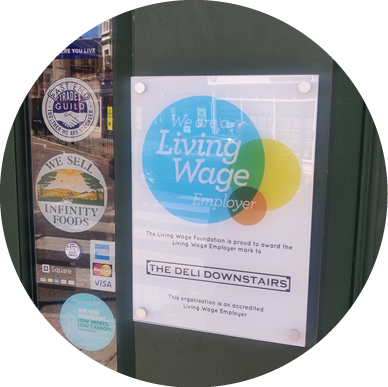
Living wage pleadge on a shop front door
Victoria Park Village, London

Make the Most of Colchester's Rich Heritage
Masterplan Layer
This masterplan layer aims to uplift Colchester’s heritage assets by improving their setting and succeed in them being experienced as a totality. It also aims to ensure new development is integrated well into the existing historic city centre.
The first set of strategic moves relate to placemaking within the city centre. This includes defining design codes that reinforce character areas, in order to create a holistic experience of Colchester’s rich and varied heritage. This also involves ensuring that new development complements and integrates well with the historic fabric.
The second set of strategic moves has to do with protecting and enhancing existing heritage assets. This includes defining anchor clusters of assets and city centre thresholds, and improving the setting and connections between them.
The Roman Circus, a unique national heritage asset, should become a key city centre attraction and along with the Roman Wall Park, an anchor for the city’s Roman story.
 Placemaking within the city centre
Placemaking within the city centre
- Using character areas to manage change
- Defining design guidance for key sites in heritage-sensitive areas
 Protecting and integrating with heritage buildings
Protecting and integrating with heritage buildings
- Reinforcing anchor clusters of heritage assets that support pedestrian footfall across the city centre
- Reinforcing heritage significance of city centre thresholds
- Improving routes between anchor clusters and city thresholds, including to the Roman Circus
- Improving the setting of individual heritage assets and providing high quality public realm connections between them.
What We Learned
- Colchester is one of the most important historic cities of England but, despite its long history, is less visited than more high profile cathedral cities
- Heavy traffic and changing retail patterns are contemporary threats to the integrity and economic sustainability of Colchester’s heritage assets
- Improvements to the public realm can help reconnect some of the fragmented parts of the city centre, allowing it to work as a unified whole.
What You Said
- Make heritage a source of pride for the city
- There should be a holistic approach to heritage, rather than focusing on bits and pieces
- Heritage can be used to encourage people to come to the city centre, as it moves away from retail
- There should be more of a focus on below-ground archaeology, such as the Roman Circus
- Implement heritage signage
- Good national examples where heritage is successfully marketed and is a large part of a city’s offer, eg. York, Chester.

Placemaking Within the City Centre
Urban Design Strategy
Placemaking within the city centre with a high degree of consideration for existing heritage should be achieved through an overall design code/design guide for the different character areas. These have been defined through mapping by building period which allows for connections and disjunctions between parts of the city centre that have a similar character.
Additional strategies should also support placemaking:
- Ensure building heights, density and built form of new developments in key sites follow character area design guidance
- Signage and wayfinding
- Shopfront design strategy
- Lighting strategy
- Public art strategy including temporary commissions and installations.
The character areas within Colchester city centre are:
Medieval and post-Medieval/early modern
These are areas where timber-framed buildings are highly prominent in a mix of building styles and fabrics.
Areas of mixed historic fabric up to 1914
These are areas where no particular style or period predominates. They include a range of buildings from Roman and Medieval to modern.
Castle Park and environs
This space consists of the castle and its parkland grounds. It is a considerable contrast to the urban fabric adjacent and the two complement each other.
Predominantly post-1945
These areas are largely post-war in character. This varies from neo-vernacular to Modernist housing and slab commercial blocks.
Sixth Form College and environs
The education campus is its own enclave and largely hidden from public view.
Character areas are described in more detail in the Appraisal Report and Heritage Report appendicies.
.png)
Bespoke signage within a sensitive historic setting
Zadar, Croatia

The Wood Street Altarpiece public artwork celebrating local places and stories gathered from the community - Eleanor Hill, Waltham Forest, Credit: rca.ac.uk

Lighting a historic structure and surrounding public realm
Visby Square, Sweden

Protecting and Integrating Heritage Assets
Urban Design Strategy
Interventions include:
- Reinforcing anchor clusters of heritage assets that support pedestrian footfall across the city centre; this includes new heritage-focused route from Colchester Town station through St Botolph’s Priory to Castle Park
- Reinforce heritage significance of city centre thresholds at North Bridge, Southway/Butt Road/Head Gate junction and Colchester Town train station
- Public realm approach and improved connectivity with the Roman Circus; short term improvements plus long-term vision and management strategy
- Improved setting of St Botolph’s Priory within the city centre, including how Britannia Yard contributes to this - see Design Frameworks for more detail
- Consider opening up to frontage of St Botolph’s Priory from St Botolph’s Street
- Proactively work with property owners to find viable and sustainable new uses for buildings at risk and disused heritage assets
- Consider the Roman Wall and its setting in its entirety - commission seperate study on the potential of a Roman Wall Park with new public realm alongside
- Many of the public realm interventions would also have a positive benefit to heritage assets - particularly looking at the churchyards as public spaces - see Public Realm, Open Space and Landscape urban design strategy
- Consider mini heritage action zone approach for run down streets eg. East Hill
- Update existing Conservation Area Appraisals and Management Guidelines to aid development control and set design quality expectations.
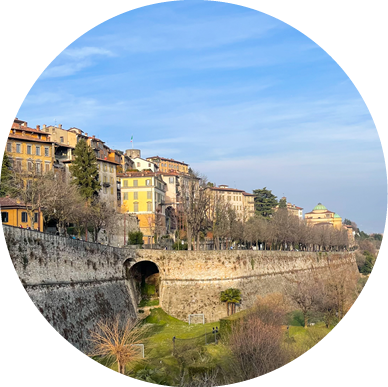
Creating a park and public space around the old city wall
Bergamo Heritage Park, Bergamo, Italy

Food hall in a historic market building
Altrincham Market, Greater Manchester

Heritage-based events and public space activation
Jorvik Viking Festival, York

